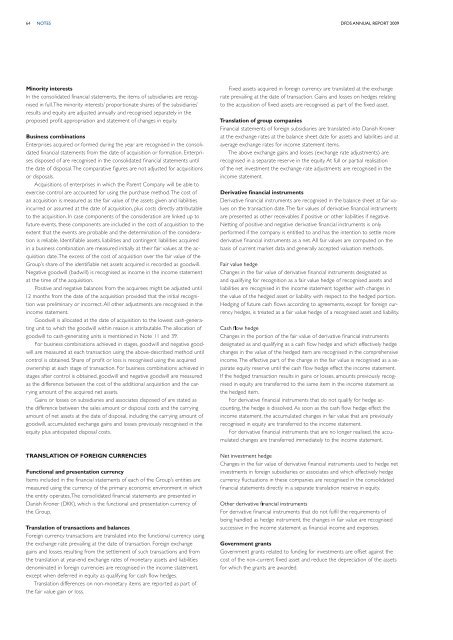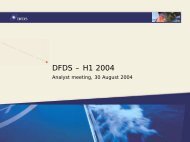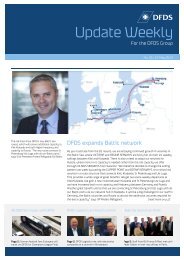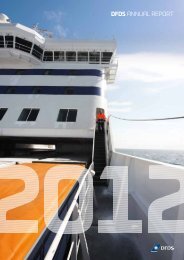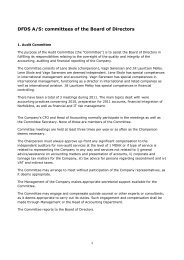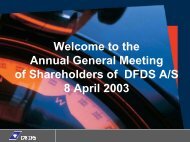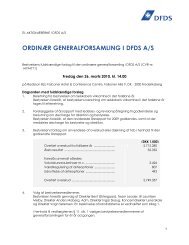English - DFDS
English - DFDS
English - DFDS
You also want an ePaper? Increase the reach of your titles
YUMPU automatically turns print PDFs into web optimized ePapers that Google loves.
64 NOTEs<br />
<strong>DFDS</strong> annual report 2009<br />
Minority interests<br />
In the consolidated financial statements, the items of subsidiaries are recognised<br />
in full. The minority interests’ proportionate shares of the subsidiaries’<br />
results and equity are adjusted annually and recognised separately in the<br />
proposed profit appropriation and statement of changes in equity.<br />
Business combinations<br />
Enterprises acquired or formed during the year are recognised in the consolidated<br />
financial statements from the date of acquisition or formation. Enterprises<br />
disposed of are recognised in the consolidated financial statements until<br />
the date of disposal. The comparative figures are not adjusted for acquisitions<br />
or disposals.<br />
Acquisitions of enterprises in which the Parent Company will be able to<br />
exercise control are accounted for using the purchase method. The cost of<br />
an acquisition is measured as the fair value of the assets given and liabilities<br />
incurred or assumed at the date of acquisition, plus costs directly attributable<br />
to the acquisition. In case components of the consideration are linked up to<br />
future events, these components are included in the cost of acquisition to the<br />
extent that the events are probable and the determination of the consideration<br />
is reliable. Identifiable assets, liabilities and contingent liabilities acquired<br />
in a business combination are measured initially at their fair values at the acquisition<br />
date. The excess of the cost of acquisition over the fair value of the<br />
Group’s share of the identifiable net assets acquired is recorded as goodwill.<br />
Negative goodwill (badwill) is recognised as income in the income statement<br />
at the time of the acquisition.<br />
Positive and negative balances from the acquirees might be adjusted until<br />
12 months from the date of the acquisition provided that the initial recognition<br />
was preliminary or incorrect. All other adjustments are recognised in the<br />
income statement.<br />
Goodwill is allocated at the date of acquisition to the lowest cash-generating<br />
unit to which the goodwill within reason is attributable. The allocation of<br />
goodwill to cash-generating units is mentioned in Note 11 and 39.<br />
For business combinations achieved in stages, goodwill and negative goodwill<br />
are measured at each transaction using the above-described method until<br />
control is obtained. Share of profit or loss is recognised using the acquired<br />
ownership at each stage of transaction. For business combinations achieved in<br />
stages after control is obtained, goodwill and negative goodwill are measured<br />
as the difference between the cost of the additional acquisition and the carrying<br />
amount of the acquired net assets.<br />
Gains or losses on subsidiaries and associates disposed of are stated as<br />
the difference between the sales amount or disposal costs and the carrying<br />
amount of net assets at the date of disposal, including the carrying amount of<br />
goodwill, accumulated exchange gains and losses previously recognised in the<br />
equity plus anticipated disposal costs.<br />
Translation of foreign currencies<br />
Functional and presentation currency<br />
Items included in the financial statements of each of the Group’s entities are<br />
measured using the currency of the primary economic environment in which<br />
the entity operates. The consolidated financial statements are presented in<br />
Danish Kroner (DKK), which is the functional and presentation currency of<br />
the Group.<br />
Translation of transactions and balances<br />
Foreign currency transactions are translated into the functional currency using<br />
the exchange rate prevailing at the date of transaction. Foreign exchange<br />
gains and losses resulting from the settlement of such transactions and from<br />
the translation at year-end exchange rates of monetary assets and liabilities<br />
denominated in foreign currencies are recognised in the income statement,<br />
except when deferred in equity as qualifying for cash flow hedges.<br />
Translation differences on non-monetary items are reported as part of<br />
the fair value gain or loss.<br />
Fixed assets acquired in foreign currency are translated at the exchange<br />
rate prevailing at the date of transaction. Gains and losses on hedges relating<br />
to the acquisition of fixed assets are recognised as part of the fixed asset.<br />
Translation of group companies<br />
Financial statements of foreign subsidiaries are translated into Danish Kroner<br />
at the exchange rates at the balance sheet date for assets and liabilities and at<br />
average exchange rates for income statement items.<br />
The above exchange gains and losses (exchange rate adjustments) are<br />
recognised in a separate reserve in the equity. At full or partial realisation<br />
of the net investment the exchange rate adjustments are recognised in the<br />
income statement.<br />
Derivative financial instruments<br />
Derivative financial instruments are recognised in the balance sheet at fair values<br />
on the transaction date. The fair values of derivative financial instruments<br />
are presented as other receivables if positive or other liabilities if negative.<br />
Netting of positive and negative derivative financial instruments is only<br />
performed if the company is entitled to and has the intention to settle more<br />
derivative financial instruments as a net. All fair values are computed on the<br />
basis of current market data and generally accepted valuation methods.<br />
Fair value hedge<br />
Changes in the fair value of derivative financial instruments designated as<br />
and qualifying for recognition as a fair value hedge of recognised assets and<br />
liabilities are recognised in the income statement together with changes in<br />
the value of the hedged asset or liability with respect to the hedged portion.<br />
Hedging of future cash flows according to agreements, except for foreign currency<br />
hedges, is treated as a fair value hedge of a recognised asset and liability.<br />
Cash flow hedge<br />
Changes in the portion of the fair value of derivative financial instruments<br />
designated as and qualifying as a cash flow hedge and which effectively hedge<br />
changes in the value of the hedged item are recognised in the comprehensive<br />
income. The effective part of the change in the fair value is recognised as a separate<br />
equity reserve until the cash flow hedge effect the income statement.<br />
If the hedged transaction results in gains or losses, amounts previously recognised<br />
in equity are transferred to the same item in the income statement as<br />
the hedged item.<br />
For derivative financial instruments that do not qualify for hedge accounting,<br />
the hedge is dissolved. As soon as the cash flow hedge effect the<br />
income statement, the accumulated changes in fair value that are previously<br />
recognised in equity are transferred to the income statement.<br />
For derivative financial instruments that are no longer realised, the accumulated<br />
changes are transferred immediately to the income statement.<br />
Net investment hedge<br />
Changes in the fair value of derivative financial instruments used to hedge net<br />
investments in foreign subsidiaries or associates and which effectively hedge<br />
currency fluctuations in these companies are recognised in the consolidated<br />
financial statements directly in a separate translation reserve in equity.<br />
Other derivative financial instruments<br />
For derivative financial instruments that do not fulfil the requirements of<br />
being handled as hedge instrument, the changes in fair value are recognised<br />
successive in the income statement as financial income and expenses.<br />
Government grants<br />
Government grants related to funding for investments are offset against the<br />
cost of the non-current fixed asset and reduce the depreciation of the assets<br />
for which the grants are awarded.


